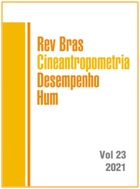Analysis of serve and serve return on different surfaces in elite tennis players
DOI:
https://doi.org/10.1590/1980-0037.2021v23e76603Resumen
The aim of the current study was to analyze players’ interactions in serve and serve return situations and examine the way points were decided due to players’ positions and surfaces. Fourteen ATP 1000 tournament matches were analyzed (7 on hard surface; 7 on clay surface). The type of surface did not affect the way points ended (?²=9.26; p > 0.05) but did influence serve return vertical positioning (?²=270.86; p < 0.001). The return positioning, both lateral (?²=92.68; p < 0.001 on deuce side - ?² = 78.98; p < 0.001 on advantage side) and vertical (?²=33.59; p < 0.001), and the type of serve (?²=45.13; p < 0.001) affected the way points were decided. The results from the present study suggest that tennis players should use, or at least seek, strategies based on aggressiveness and consistency of the 1st serve and also indicate that in the 2nd serve return, players are more offensive, and that on hard surfaces, players stand a few steps inside the court to return the serve, differently from clay surfaces. It recommended that serve returns should combine aggression, by inside the court positioning, and accuracy.
Citas
Hughes MD, Bartlett RM. The use of performance indicators in performance analysis. J Sports Sci. 2002;20(10):739-54.
O’Donoghue P, Liddle S. A match analysis of elite tennis strategy for ladies’ singles on clay and grass surface. In: Proceedings of the science and racket sports II. London, FN Spon; 1998. p. 247-53.
O’ Donoghue P, Ingram B. A notational analysis of elite tennis strategy. J Sports Sci. 2001;19(2):107-15.
Capel-Davies J, Page J, Chong N. ITF approved tennis balls, classified surfaces & recognised courts 2015. London, International Tennis Federation; 2015.
Cross R, Pollard G. Grand Slam men’s singles tennis 1991-2009 serve speeds and other related data. ITF Coach Sport Sci Rev. 2009;16(49):8-10.
Collinson L, Hughes M. Surface effect on the strategy of elite female tennis players. J Sports Sci. 2003;21(4):266-7.
Hizan H, Whipp PR, Reid M. Validation of match notation (a coding system) in tennis. J Quant Anal Sports. 2010;6(3):1-13.
Haake S, Rose P, Kotze J. Reaction time testing and grand slam tie-break data. In: Proceedings of the tennis science and technology. Oxford, Blackwell Science; 2000. p. 269-78
Gillet E, Leroy D, Thouvarecq R, Stein JF. A notational analysis of elite tennis serve and serve-return strategies on slow surface. J Strength Cond Res. 2009;23(2):532-9.
Carvalho J, Araújo D, Travassos B, Esteves P, Pesanha L, Pereira F, Davids K. Dynamics of players relative positioning during baseline rallies in tennis. J Sport Sci. 2013;31(14):1596-605.
Palut Y, Zanone PG. A dynamical analysis of tennis: concepts and data. J Sports Sci. 2005;23(20):1021-32.
Gullikson T, MacCurdy D. Fast court tactics - part 2. ITF Coach Sport Sci Rev. 2002;28(1):2-3.
Kleinoder H, Mester J. Strategies for the return of 1st and 2nd serves. In: Proceedings of the tennis science and technology. Oxford, Blackwell Science; 2000. p. 401-8.
Hughes M, Franks I.. Notational analysis: a review of the literature. In: Notational analysis of sport. London: Routledge; 2004. p. 59-106.
Takahashi H, Wada T, Maeda A, Kodama M, Nishizono H, Kurata H. The relationship between court surface and tactics in tennis using a computerized scorebook. Int J Perf Anal Spor. 2006;6(2):15-25.
Descargas
Publicado
Número
Sección
Licencia

Direitos Autorais para artigos publicados nesta revista são do autor, com direitos de primeira publicação para a revista. Em virtude da aparecerem nesta revista de acesso público, os artigos são de uso gratuito, com atribuições próprias, em aplicações educacionais e não-comerciais, desde que seja dada a atribuição. Esta obra foi licenciada com uma Licença Creative Commons Atribuição 4.0 Internacional - CC BY


